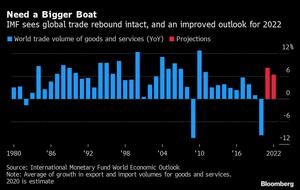 In this file photo taken on June 30, 2015 a logo is seen outside the headquarters of the International Monetary Fund in Washington, DC. (BRENDAN SMIALOWSKI / AFP)
In this file photo taken on June 30, 2015 a logo is seen outside the headquarters of the International Monetary Fund in Washington, DC. (BRENDAN SMIALOWSKI / AFP)
The International Monetary Fund raised its forecast for global growth this year, betting the rollout of coronavirus vaccines and more fiscal stimulus will offset the immediate challenge posed by the resurgent pandemic.
Global gross domestic product will soar 5.5 percent this year, faster than the 5.2 percent projected in October, the fund said Tuesday. It credited improvement in the US for much of the upgrade, which was offset by cuts to its predictions for the euro area and UK.
The IMF also said that more than 150 economies are expected to have per-capita income levels in 2021 that are below 2019 while nearly 90 million people are likely to fall into extreme poverty by year-end
Such an expansion would match 2007 as the best in four decades of data and follow an upwardly revised 3.5 percent contraction last year, which would still be the worst peacetime decline since the Great Depression. The IMF projected a 4.2 percent global expansion for 2022.
READ MORE: IMF: Digital, ecology key to even recovery
“Much now depends on the outcome of this race between a mutating virus and vaccines to end the pandemic, and on the ability of policies to provide effective support until that happens,” IMF Chief Economist Gita Gopinath wrote in a blog post accompanying the World Economic Outlook.
The fund sees major central banks holding their policy-rate settings through 2022, with financial conditions remaining at current levels for advanced economies and improving for emerging-market and developing nations.
The US saw one of the biggest upgrades after approving a US$900 billion relief plan. President Joe Biden is also seeking US$1.9 trillion in additional aid. The IMF forecasts the world’s largest economy may grow 5.1 percent this year, versus 3.1 percent in October.

Japan, which has announced its own stimulus of more than US$700 billion, also saw a significant upward revision. The fund now projects 2021 economic growth at 3.1 percent compared with 2.3 percent previously.
ALSO READ: ILO: Global labor market to see fragile recovery after 2020 losses
Those upbeat outlooks contrast with Europe, where a deluge of cases has spurred new restrictions. The euro-area growth forecast was cut by a full percentage point, to 4.2 percent, on the expectation that the cooling at the end of last year will continue. The UK was cut by almost a point and a half to 4.5 percent.
China’s economy is expected to expand by 8.1 percent in 2021 and 5.6 percent in 2022.
Overall, advanced economies will see output losses compared to pre-pandemic projections that are relatively smaller than elsewhere thanks to fiscal and monetary policy support and earlier, widespread access to vaccines.
The projections assume broad vaccine availability in advanced economies and some emerging markets this year and across most countries by the second half of next year. They also incorporate potential new lockdowns before inoculation is widespread, and that social distancing continues until the pandemic is tamed.

Still, forecasters face many unknowns. They include how restrictions to curb infection affect the economy before widespread inoculation, how vaccine rollout expectations and policy support influence activity, and changes in financial conditions and commodity prices.
ALSO READ: UN: World economic recovery of 4.7% to barely offset 2020 losses
For global trade, the IMF sees import and export volumes rising by 8.1 percent this year, slightly less than the 8.3 percent increase seen in October, after an estimated 9.6 percent decline last year.
The IMF will follow the release of the economic forecasts this week with an updated Global Financial Stability Report on Wednesday and an update to its Fiscal Monitor on Thursday.
The IMF also said that more than 150 economies are expected to have per-capita income levels in 2021 that are below 2019 while nearly 90 million people are likely to fall into extreme poverty by year-end.
It added that social unrest amid higher inequality or unequal vaccine access could further complicate the recovery.
READ MORE: OECD cuts global forecast, warns govts to maintain support
World leaders should work together closely to speed vaccination in nations with low health-care capacity and provide debt relief for low-income and developing countries with unsustainable burdens, it added.
With Reuters inputs


